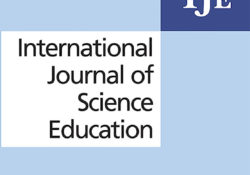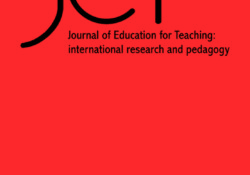tandfonline.com har udgivet en rapport under søgningen “Teacher Education Mathematics”: ABSTRACT ABSTRACT Previous research suggests that students use metaphors when asked to explain digestive processes and nutritional uptake. In this paper, we describe the results of a study designed to gain a deeper understanding of how metaphors and anthropomorphisms are used by students when describing such processes. We applied analyses based on the systemic-functional grammar framework to 123 student responses to a question about nutrition on a Swedish national test in biology in order to identify, describe and analyse how students use metaphors and to understand the linguistic structure of those metaphors. We also considered how the metaphors are linked to metaphor systems and anthropomorphisms, thereby gaining a deeper understanding of the role of metaphors in this area. The results… Continue Reading →
Like this:
Like Loading...
eric.ed.gov har udgivet: This paper contributes to the theory and evidence that mathematical cognition is embodied. Drawing on the practices of primary teachers in South Africa engaged in a longitudinal research and development project — Wits Maths Connect–Primary — we report on aspects of lessons aimed at developing number sense through whole-class teacher-learner interaction. Two episodes are analysed from an embodied cognition perspective. The episodes focus on helping Grade 1 (6-year-olds) learners become fluent in counting forward and back or ordering numbers. Analysis reveals different embodied metaphors underlie the teachers’ actions, the nature of which are likely to lead to different learning opportunities. We conclude that our analysis supports a theory of embodied cognition, and demonstrates its usefulness as an analytical tool. [For the complete proceedings, see ED597799.] Link til… Continue Reading →
Like this:
Like Loading...
tandfonline.com har udgivet en rapport under søgningen “Teacher Education Mathematics”: Abstract Metaphors are devices that people employ for both poetic purposes and rhetorical elaboration and belong to the realm of extraordinary language. Metaphors are used to connect abstract ideas and information to more concrete experiences, thus making these experiences more familiar and easier to understand. Moreover, metaphors are more than symbolic intellectual processes; they influence the conceptual understanding of our experiences and help define our everyday realities. For education, there is an important and relevant practical connection between the metaphors that teachers employ and their beliefs about teaching and classroom practices. This stems from the notion that metaphors guide one’s mental framework. In order to gain a deeper understanding of the metaphors influencing teachers in gifted education, this study specifically… Continue Reading →
Like this:
Like Loading...
tandfonline.com har udgivet en rapport under søgningen “Teacher Education Mathematics”: Link til kilde
Like this:
Like Loading...
eric.ed.gov har udgivet: Ideals play a key role in a student teachers’ identity work. They form targets to strive for and a mirror for reflection. In this paper, we examine Finnish mathematics student teachers’ metaphors for the teacher’s role (N=188). We classified the metaphors according to a model that identified teachers as subject matter experts, didactical experts, and pedagogical experts, with the addition of another two categories, self-referential and contextual. For the exploration of emerging professional identities, we studied the self-referential metaphors, which formed the most common category in the data. We observed that every third metaphor described either student teachers’ personalities or their incompleteness as teachers, or new beginnings or eras. Although these aspects were expected, they also inform us as teacher educators of the values and ideals that… Continue Reading →
Like this:
Like Loading...
eric.ed.gov har udgivet: Preservice elementary teachers hold a variety of beliefs about mathematics and mathematics learning, which influence their teaching. Previous research has shown that preservice elementary teachers believe that mathematics is doing arithmetic. However, it is unclear if preservice elementary teachers truly believe that mathematics is only arithmetic, or if they simply have a difficult time describing their views on mathematics. In this study, preservice elementary teachers were asked to provide metaphors for mathematics and mathematics learning in order to illuminate the preservice teachers’ beliefs about mathematics. The metaphors were analyzed to reveal twelve different categories of belief. Approximately one-fourth of the metaphors suggested negative views about mathematics and mathematics learning. Approximately 44% of the metaphors described mathematics and mathematics learning as something that one must engage in as… Continue Reading →
Like this:
Like Loading...
eric.ed.gov har udgivet: In this study, teachers’ perceptions of prospective Turkish teachers (that is, those who have completed their undergraduate studies) in the fields of Science, Mathematics and Social Sciences are investigated through teacher metaphors. These perceptions were classified in accordance with their answers to two open-ended questions within a metaphoric structure used as the data collection tool. This classification employs the tripartite metaphorical classification developed by Martínez et al. and includes the following perspectives: Transmissive, constructivist, and situative. In the study, 58 different teacher metaphors were identified. As a result of the research, metaphors within the Transmissive class were observed predominantly in prospective teachers of both groups, followed by Constructivist in prospective Science and Math teachers, and Situative in prospective Social Science teachers. Findings from the study are also… Continue Reading →
Like this:
Like Loading...


